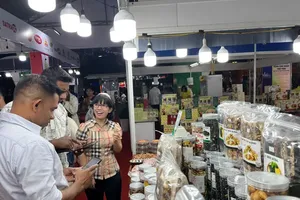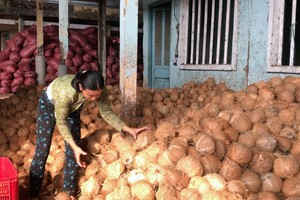
Accordingly, the survey on the business trends of enterprises in the processing and manufacturing industries in the third quarter of this year shows that 32.2 percent of enterprises assessed their production and business situation in the third quarter better than in the second quarter; 31.9 percent of enterprises said that they faced difficulties; 35.9 percent of enterprises said that the business and production situation was stable.
Evaluating the business situation in the last quarter of this year compared to that in the third quarter, 45.6 percent of enterprises expected that the trend would be better; 19 percent of enterprises forecast that the situation would be more difficult; 35.4 percent enterprises said that the business and production situation would be stable. In which, the FDI sector was the most optimistic, with 82.8 percent of enterprises forecasting better or stable business and production situation in the fourth quarter of this year, compared to the third quarter. This rate in the state-owned and non-state enterprises sectors is 81.7 percent and 80.2 percent, respectively.
In terms of production volume, 36 percent of enterprises said that the third quarter was higher compared to the second quarter; 30 percent of enterprises saw a reduction; 34 percent of enterprises said it was stable. 45.9 percent of enterprises expected production volume to increase in the fourth quarter; 17.5 percent of enterprises forecast the opposite; 36.6 percent predicted production volume to be stable.
As for the number of orders, 30.9 percent of enterprises had more orders in the third quarter than in the second quarter; 30.6 percent of enterprises experienced a slump in the number of orders; 38.5 percent of enterprises had stable orders.
Regarding export orders, 26.5 percent of enterprises affirmed that the number of new export orders was higher; 32.6 percent of enterprises had fewer new export orders; 40.9 percent of enterprises had stable new export orders. There is 35.6 percent of enterprises saying that new orders will increase in the fourth quarter; 20.4 percent of enterprises expected a decrease in new orders; 44 percent of enterprises expected new orders to be stable.
Although the survey results show that enterprises are quite optimistic, according to the GSO, in the first nine months of this year, the number of enterprises temporarily suspending their operations with a time limit is 38,600 enterprises, an increase of 81.8 percent compared to the same period of last year; 27,600 enterprises ceased their operations to wait for dissolution procedures, down 2.4 percent; nearly 12,100 enterprises completed dissolution procedures, up 0.1 percent; 36,500 enterprises were inactive at the registered addresses, an increase of 39.6 percent.
It is recorded in Ho Chi Minh City that what worries enterprises most is that purchasing power is still at an extremely low level. Mr. Phan Van Dung, Deputy General Director of Vissan Joint Stock Company, said that the selling prices of many items were stable at low levels. Even pork after increasing highly, the prices of pork have started to go down, and the supply of pork has also been more abundant. However, the purchasing power for fresh cattle meat and processed foods is extremely slow. Currently, Vissan has adjusted its production and business plan in 2020 in accordance with reality. Other manufacturing enterprises, such as Vinh Thanh Dat and Ba Huan, also repeatedly changed their revenue growth plans because the purchasing power in the market at this time has not improved.
Similarly, distribution companies also continuously adjusted their business plans, ran more promotional campaigns, and offered discounts to stimulate consumer demand. According to the representative of MM Mega Market Company, if the revenue is equal to that in 2019, it will be the success of the enterprise amid the current situation.
Many people also said that by the end of this year, consumers would continue to tighten spending and tend to give priority to food items, essential products, as well as healthcare products. As for the group of other secondary items, such as fashion or electronics, and non-food, the recovery is not significant. This is expected to provide opportunities for local producers. However, to gain confidence and increase purchasing power, local suppliers need to provide products with quality and value that meet the general needs of consumers and ensure the presence of products on the shelves.
Although having not been able to recover as before the Covid-19 pandemic, in the last months of the year, Vietnam's retail market in general and Ho Chi Minh City’s, in particular, will be more prosperous than the past months. The domestic market continues to play the role of the impulse to production for enterprises in the area. Retail sales of goods for this year are forecast to grow by 10-10.5 percent compared to last year.
Evaluating the business situation in the last quarter of this year compared to that in the third quarter, 45.6 percent of enterprises expected that the trend would be better; 19 percent of enterprises forecast that the situation would be more difficult; 35.4 percent enterprises said that the business and production situation would be stable. In which, the FDI sector was the most optimistic, with 82.8 percent of enterprises forecasting better or stable business and production situation in the fourth quarter of this year, compared to the third quarter. This rate in the state-owned and non-state enterprises sectors is 81.7 percent and 80.2 percent, respectively.
In terms of production volume, 36 percent of enterprises said that the third quarter was higher compared to the second quarter; 30 percent of enterprises saw a reduction; 34 percent of enterprises said it was stable. 45.9 percent of enterprises expected production volume to increase in the fourth quarter; 17.5 percent of enterprises forecast the opposite; 36.6 percent predicted production volume to be stable.
As for the number of orders, 30.9 percent of enterprises had more orders in the third quarter than in the second quarter; 30.6 percent of enterprises experienced a slump in the number of orders; 38.5 percent of enterprises had stable orders.
Regarding export orders, 26.5 percent of enterprises affirmed that the number of new export orders was higher; 32.6 percent of enterprises had fewer new export orders; 40.9 percent of enterprises had stable new export orders. There is 35.6 percent of enterprises saying that new orders will increase in the fourth quarter; 20.4 percent of enterprises expected a decrease in new orders; 44 percent of enterprises expected new orders to be stable.
Although the survey results show that enterprises are quite optimistic, according to the GSO, in the first nine months of this year, the number of enterprises temporarily suspending their operations with a time limit is 38,600 enterprises, an increase of 81.8 percent compared to the same period of last year; 27,600 enterprises ceased their operations to wait for dissolution procedures, down 2.4 percent; nearly 12,100 enterprises completed dissolution procedures, up 0.1 percent; 36,500 enterprises were inactive at the registered addresses, an increase of 39.6 percent.
It is recorded in Ho Chi Minh City that what worries enterprises most is that purchasing power is still at an extremely low level. Mr. Phan Van Dung, Deputy General Director of Vissan Joint Stock Company, said that the selling prices of many items were stable at low levels. Even pork after increasing highly, the prices of pork have started to go down, and the supply of pork has also been more abundant. However, the purchasing power for fresh cattle meat and processed foods is extremely slow. Currently, Vissan has adjusted its production and business plan in 2020 in accordance with reality. Other manufacturing enterprises, such as Vinh Thanh Dat and Ba Huan, also repeatedly changed their revenue growth plans because the purchasing power in the market at this time has not improved.
Similarly, distribution companies also continuously adjusted their business plans, ran more promotional campaigns, and offered discounts to stimulate consumer demand. According to the representative of MM Mega Market Company, if the revenue is equal to that in 2019, it will be the success of the enterprise amid the current situation.
Many people also said that by the end of this year, consumers would continue to tighten spending and tend to give priority to food items, essential products, as well as healthcare products. As for the group of other secondary items, such as fashion or electronics, and non-food, the recovery is not significant. This is expected to provide opportunities for local producers. However, to gain confidence and increase purchasing power, local suppliers need to provide products with quality and value that meet the general needs of consumers and ensure the presence of products on the shelves.
Although having not been able to recover as before the Covid-19 pandemic, in the last months of the year, Vietnam's retail market in general and Ho Chi Minh City’s, in particular, will be more prosperous than the past months. The domestic market continues to play the role of the impulse to production for enterprises in the area. Retail sales of goods for this year are forecast to grow by 10-10.5 percent compared to last year.


















)





